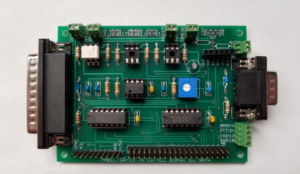MABEL DR-1x Control board kit

Description:
The MABEL interface and software allows analog control of the Yaesu DR-1X repeater and access to the AllStar VOIP network with the Raspberry Pi3 and the HamVOIP ver. 1.5 release.
Operation:
MABEL functions by intercepting the PTT and CTCSS signals before they are sent to AllStar. Substitute signals are then generated by MABEL and sent to the USB radio Adapter and repeater. In Allstar with MABEL operation, the DR-1X repeater controller is configured to operate in the AUTO-AUTO mode. The DR-1X internal repeater controller is configured to not activate on the assigned CTCSS tone by setting it to some unused tone. Instead, the desired CTCSS signal is decoded by the SC-50DW, SC -75DW or CT-30DW decoder. MABEL monitors this CTCSS detected signal from the SC-50DW, SC-75DW or CT-30DW, as well as the PTT signal from Allstar via the USB Radio Adapter interface. Upon receiving a valid CTCSS signal or PTT signal, MABEL first checks the RF Detector signal to ensure the DR-1X transmitter is not active, then initiates a switch to the FM mode. Checking the RF Detector signal prevents the DR-1X from locking-up during the switch. (NOTE: Using the RF Detector output eliminates the need to splice into an internal cable in the DR-1X to verify the transmitter is not active.)
MABEL completes the switch to the FM mode in less than 200 milliseconds. The substitute CTCSS signal is applied to the USB Radio Adapter less than 1 millisecond later, allowing Allstar to perform its normal repeater controller and linking tasks. Similarly, the substitute PTT signal from MABEL is applied to the DR-1X transmitter.
Since MABEL works by intercepting the CTCSS and PTT signals and monitoring the transmitted RF signal, no modifications are required to the Allstar program.
Control:
In Digital mode on the DR-1X audio and control is still retained by the DR-1X. In analog mode MABEL allows the DR-1X to be handled just like a normal repeater controller would with the addition of access to the AllStar VOIP network. All analog audio can be passed on to AllStar through this mode. No more interfacing the DR-1X to a standard controller and dealing with lockups and stability issues. Also, no need to tie up a separate port on a conventional controller for the AllStar sever or node radio. This all in one solution is the next step in combining an Internet link-able and fully customizable controller with the DR-1X.
System:
The system is composed of 3 separate boards.
-
The main MABEL board
-
The SC-50DW, SC-75DW or CT-30DW CTCSS Tone boards offered from Masters Communications.
-
The RA-40 or RA-42 board offered from Masters Communications.
(Links to purchase the additional boards are on the Files page or you can go directly to www.masterscommunications.com to purchase these, or any one of their other great products)
These board together offer the some of the best possible audio and signal control possible. The SC-50DW or SC-75DW board provides the MABEL setup with the famous MICOR bi-level squelch to feed the DR-1X. Optionally you can use the CT-30DW board to provide the needed CTCSS receive signal. The RA-40 / RA-42 board provides the interface to the Raspberry Pi and also delivers more than enough clean audio to modulate the DR-1X.
Additional add-ons:
An 8 channel DTMF Relay board can be added for control of virtually anything one can think of, such as:
-
power cycling the DR-1X
-
turning on/off site equipment
-
coax transfer switch
-
Raspberry Pi power
The list is endless.
The DTMF functions can be performed over the air as with a normal controller or over the Internet via the Raspberry Pi. No more dedicated phone lines needed for control of the repeater controller.
MABEL generates your required CTCSS tone with a program called PiTone. This is already included in the MABEL download and is user configurable. The use of this program requires the addition of a DAC module MCP4725. This can be purchased separately from various online suppliers.
The system is designed to prevent lockups caused by the Pi locking up or the AllStar software crashing. The use of the Adafruit ATTiny85 board allows the system to monitor the heartbeat signal and respond automatically by resetting the power supply to the Pi without a trip to the site. The ATTiny85 board can be purchased direct from Ada fruit or other vendors.
Two additional Optocouplers sockets are provided for dual 5 to 16 volt user inputs to the Pi’s GPIO, if needed for your application or future development.
PiTone Executable and Source Code Files:
The PiTone Ver. 3 executable source code files can be downloaded from our Files page.
PiTone will run on a Pi Zero, 2, 3 or 4. However, when using the TxCTCSS input feature with a Pi 4, the GPIO input cannot be driven from an open collector or drain source unless a 56K pull-up resistor to 3.3 VDC is provided. This is due to a WiringPi library bug in which the internal pull-up cannot be activated by WiringPi. PiTone v3 must be compiled using the latest WiringPi library to run on a Raspberry Pi 4.
PiTone by K8UT is free software; you can redistribute it and/or modify it under the terms of the license agreement found in the source code.